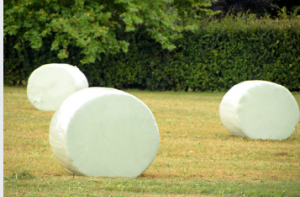If you’re looking for a better way to wrap your Net Wrap silage, consider purchasing a high-quality clear bale wrap. The material has multiple layers, including the outer layer, a UV stabilizer, and the inner layer, which is more resistant to punctures. The thickness of the wrap is indicated by the millimetres printed on it. Choose a thicker wrap if your bales tend to have too much air, as it may cause the forage to ferment.
 It is vital to remember that the wrapped material should have a high dry matter content, between 30% and 50%. If the starting material is drier, it will require more pressing and compacting. Therefore, make sure that the material is completely dry before wrapping. Ideally, two hours is sufficient. The bales should be stored on a level surface, free of dust and moisture. Avoid direct sunlight, as it can damage the film and reduce its effectiveness.
It is vital to remember that the wrapped material should have a high dry matter content, between 30% and 50%. If the starting material is drier, it will require more pressing and compacting. Therefore, make sure that the material is completely dry before wrapping. Ideally, two hours is sufficient. The bales should be stored on a level surface, free of dust and moisture. Avoid direct sunlight, as it can damage the film and reduce its effectiveness.
To prevent cracks and holes in the plastic, keep the bales stored on a gravel bed. It prevents vermin from chewing through the plastic film. If the ground beneath the bale is soft, use a net wrap. The net wrap also helps contain stems and leaves, reducing the risk of poking holes in the plastic film. Lastly, it makes the surface of the silage plastic wrap smooth and easy to handle.
There are many different types of Net Wrap silage wraps available on the market, and each has its unique qualities. A standard bale wrap is 750mm wide and 1,500 metres long. But if you need a longer roll, consider purchasing a Silotite Pro, which is 20mm thick and has a more flexible plastic. You may also opt for a silage wrap thinner than the standard bale wrap. If there is no UV protection, you’ll have to cover the bales with a net wrap. You can also use a used bale wrap if this doesn’t work.
A high-quality film is essential to protect the nutrition of your bale silage. Its polyethylene resins will provide excellent cling and puncture resistance. The film will also help preserve the nutritional value of the ensiled crop. The higher the quality of the film, the more valuable it is. If you want to buy a good-quality silage wrap, you can consult a professional in your area.
During storage, silage wrap should be stored on a solid base. It will prevent condensation in the room and reduce the risk of mould. However, the film must be stored at temperatures between 15 and 30 degC. Similarly, it must be protected from UV radiation, damaging the plastic. It is important to store the bales on a stable surface to prevent mould development. The film should also be stored on the side of the barn to minimize the risk of damage to it.
Another consideration is the quality of the film. It should be resistant to water. When silage is stored in a dip, it may remain wet for prolonged periods. If this happens, the film will start to degrade and need to be replaced. Nevertheless, it should not be discarded, as it will be ruined once the bale is placed in a storage shed. If the bales are too damp, it will ruin the quality of the feed.
The material used for silage wrap should be ideally flat and free from plants. The ground should be free of stubble, which can damage the film and cause it to crack. Moreover, it should be free of UV-rays to prevent mould from forming on the plastic. If there is no UV protection, you’ll have to cover the bales with a net wrap. You can also use a used bale wrap if this doesn’t work.
The right Net Wrap silage wrap should be durable. It should be able to withstand a lot of heat and UV rays. Moreover, it should not be fragile or tear easily. A good silage wrap will protect the bale from all these risks. A good one will keep your bales fresh for several weeks, and it should be able to withstand a heavy workload. Its durability can last for years.